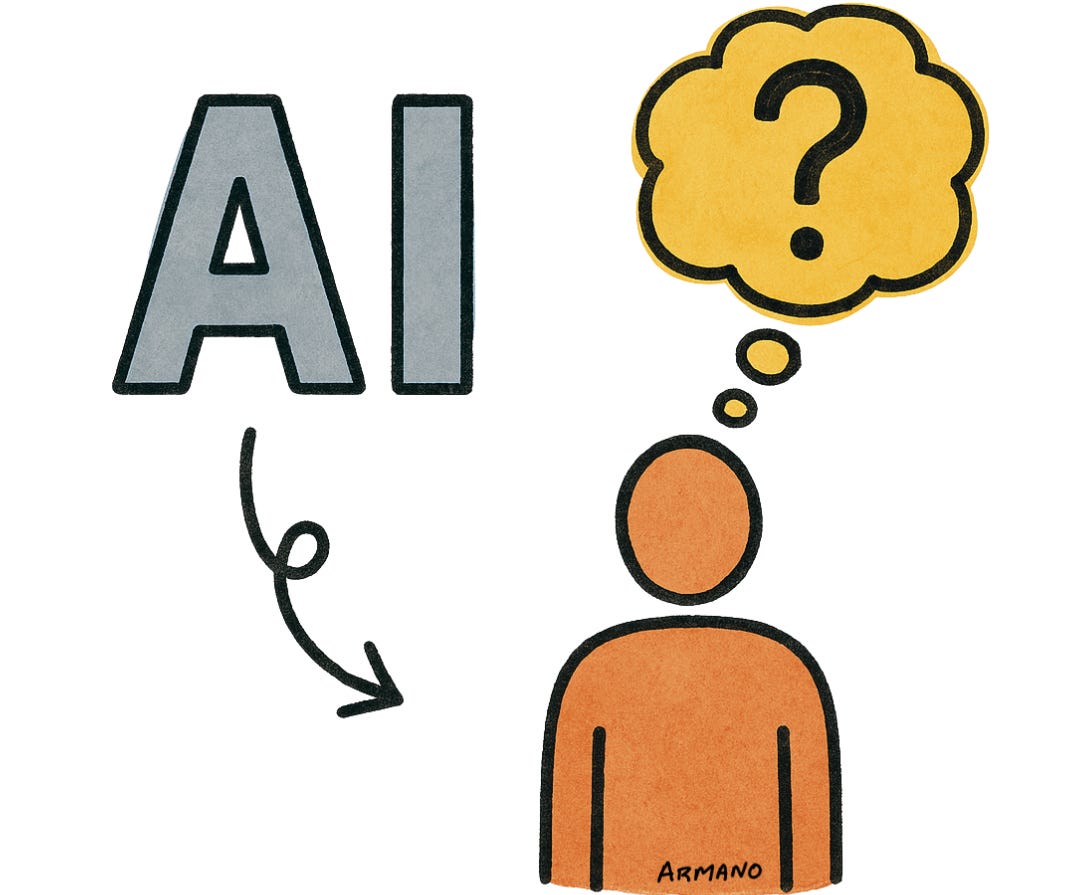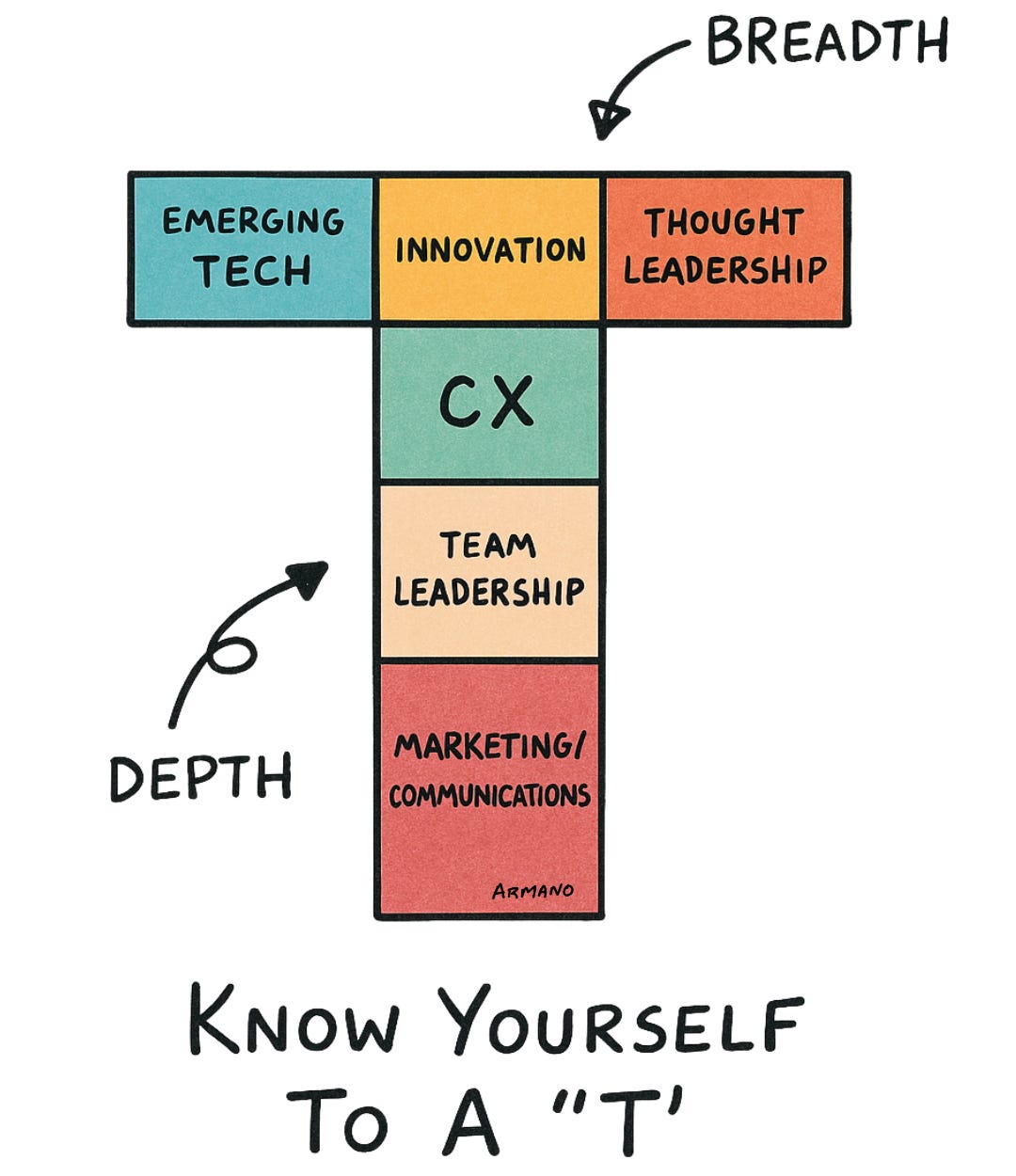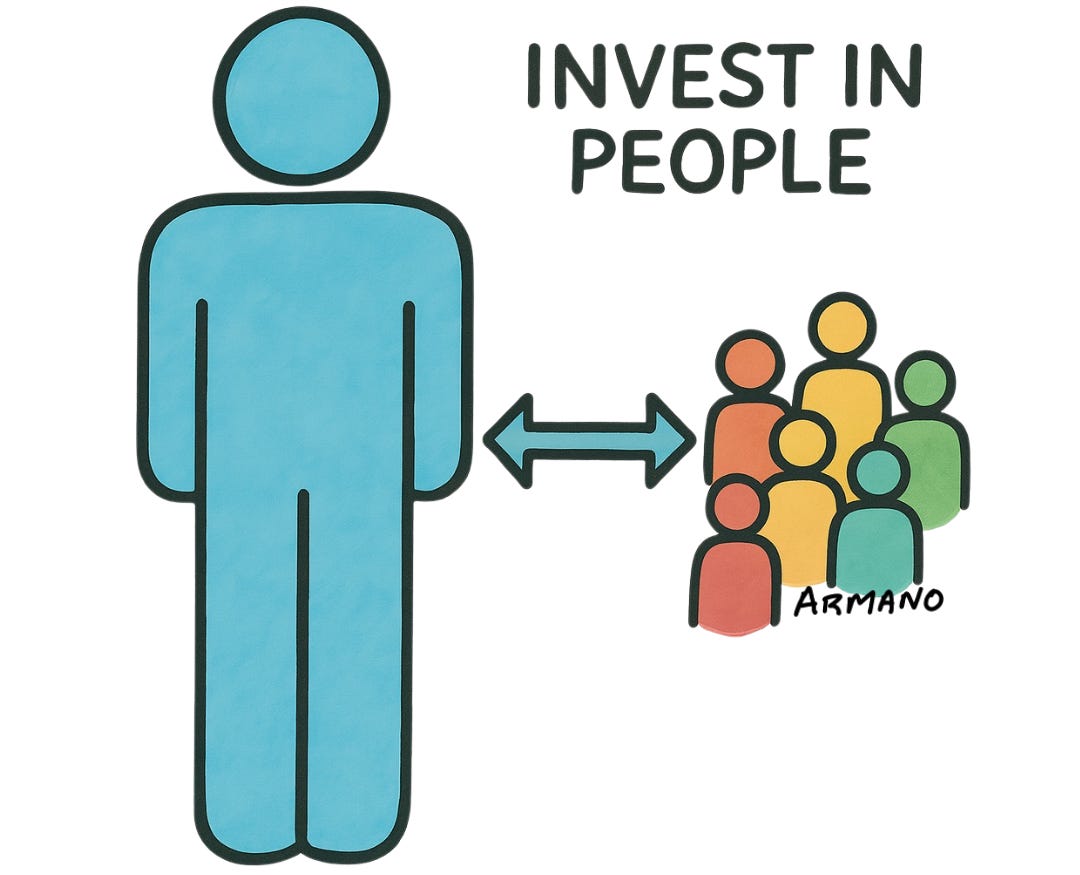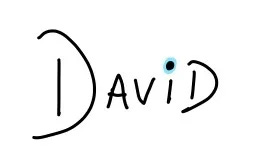AI-Proofing Your Career, by Design
Building On Your T-Shaped Foundation Of Breadth And Depth
I was an early adopter of Generative AI. Before LLMs emerged, I was working in the field of conversational AI, which once consisted of a now-archaic system that combined natural language processing with manually constructed decision trees. Personality and voice/tone were crafted by writers, not learned by humans collaborating with machine. LLMs changed all of that overnight, and I had a front row seat to it. Beyond my day job at an AI agent startup, I also got my hands dirty with ChatGPT, just days after its public release in 2022. Almost instantly after using it for a few hours, my first thought was:
This is going to do to white-collar work what things like robotics and modern manufacturing techniques have done to industrial jobs…
I’ve watched the AI discussion unfold over the past few years, and if I had to summarize it in sequence, I’d say it has been going down as follows:
-AI is going to create new companies, jobs, and industries
-AI won’t replace your job, but somebody using AI might
-AI will eventually replace your white collar job
-AI will cure all diseases and advance humanity
-AI will be humanity’s undoing
But maybe that sequence is a living loop, because all of the “experts” seem to be taking different stances at different times. Let’s call it “The AI Anxiety Cycle:
Beyond the extreme views of blind optimism and AI-anxiety lies the more pragmatic probability that both these cautious concerns and optimistic outlooks have a degree of truth to them. As with much in life, there are nuances and permutations of possibilities that often determine the outcomes. That said, AI is going to be disruptive to specific industries. It’s increasingly clear which sectors and jobs are on the front lines of AI disruption. High-paying white-collar roles, such as office clerks, paralegals, software engineers, and financial analysts, are particularly vulnerable, as generative AI increasingly handles complex documents, coding, and data analysis.
Other professional and business services—especially in law, media, and IT—are experiencing both anxiety and opportunity; some leaders warn that entry-level roles might disappear entirely. However, sectors such as STEM, healthcare, and cybersecurity are projected to grow, driven by the need to build, manage, and govern AI systems, making adaptability and AI fluency the critical skill differentiators moving forward.
The question must be asked: Is it possible to AI-proof our careers amongst all of this uncertainty and anxiety? I think there are some things we can do to help ourselves:
Don’t Stop At Upskilling
I’m not here to dunk on upskilling. The idea of sharpening your skills, learning new tools, and staying current—it all makes sense. But we’ve somehow made upskilling the endgame, when in reality, it’s just the starting point. In the age of AI, the shelf life of any single skill is shrinking fast. What we’re talking about isn’t just “upskilling”—it’s reframing, retooling, and in some cases, reimagining our roles entirely.
The traditional narrative goes something like this: companies will offer training, employees will upskill, and the future of work will be solved. However, here’s the rub—most of the time, upskilling is either treated as an individual responsibility or relegated to a corporate learning portal that nobody uses. True adaptation requires more than just tacking on a new skill. It’s a shared responsibility between employer and employee—and even then, it only works if it’s part of a larger shift in mindset.
So yes, upskill. But don’t stop there. Ask the harder questions: Where is your role headed? What parts of your job are likely to be automated? Charlene Li is an author, keynote speaker, and C-suite whisperer. I’ve been fortunate to get to know her a bit over the years. She recently shared her adventures in “Vibe Coding,” i.e., using some of the latest AI tools to help a non-engineer build a digital product, such as an app. Charlene speaks “executive” like nobody else, yet here she is diving into Vibe coding and getting deep into the weeds of it all, experimenting along the way… That’s not upskilling, that’s complete and total immersion:
“So I jumped in, starting with Lovable (a tool many friends recommended). The interface was beautiful, with prompts on the left, and a live app preview on the right. It created a gorgeous front end, and could actually pull from Google calendars and find open meeting times.
But then it got stuck. Google authentication became my nemesis.”
- Charlene Li
Learn To LAR
If you’re serious about staying relevant in the age of AI, you need to learn to LAR: Learn, Adapt, Reinvent:
Learning is where everything starts. Not just technical upskilling, but deeper learning—understanding systems, shifts, human behavior. It’s not enough to know what’s changing. You need to understand why it’s changing.
Adapting means putting learning into motion. It’s about reapplying your experience in new contexts, testing ideas in unfamiliar territory. Adapting is messy. It doesn’t always feel like progress. But it’s where resilience is forged.
Reinventing is the payoff—but it’s also part of the never-ending process. It’s a key checkpoint that often requires repeating. Reinvention is when you integrate what you’ve learned and how you’ve adapted into something new, whether it’s a role, a mindset, or a body of work.
This cycle… LAR is continual. It’s how we build career durability when nothing is stable. Take Satya Nadella, for example. Before becoming CEO of Microsoft, he led its cloud division, learning about the future of enterprise technology. He adapted Microsoft’s culture from one of competition to one of collaboration, and in doing so, reinvented the company’s identity around empathy and purpose. He’s still LAR-ing—and so are the people around him.
“Don’t be a know‑it‑all. Be a learn‑it‑all.”
-Satya Nadella
Learning to LAR leads to personal and professional growth.
Know Yourself To a “T”
The concept of T‑shaped people: depth in one core area plus breadth across others—was popularized by Tim Brown, CEO of IDEO. He argues that building teams of individuals with deep expertise and the ability to collaborate broadly is foundational to innovation and resilience. That’s why understanding your T‑shape isn’t just a personal exercise; it’s the bedrock of career longevity.
In the model below, which I created for myself, the vertical stem highlights where my deepest expertise lies—CX (Customer Experience), team leadership, and marketing/communications—while the horizontal bar reflects where I bring broader value: emerging tech, innovation, and thought leadership. Knowing yourself to a “T” is how you’ll build career longevity, because you’re bringing your full value vs. chasing fickle, fleeting trends.
When you lean into your deep zone, you anchor your performance. When you expand along the breadth axis, you stay relevant, adaptive, and able to collaborate across domains. The magic happens when those two combine dynamically—when you own what you’re great at, while staying curious, agile, and fluent in adjacent spaces.
Tim Brown put it simply:
“T‑shaped people…have a principal skill that describes the vertical leg of the T… but are so empathetic that they can branch out into other skills… and recognize patterns of behavior that point to universal human needs”.
Knowing yourself to a T isn’t just an exercise—it’s a mindset. It’s a practice of self-awareness, continual growth, and intentional breadth.
Own Your Personal T: A Quick Exercise
Start with the stem – Write down the one or two areas where you have the deepest experience. Where do people consistently come to you for insight or leadership?
Add the crossbar – List adjacent domains where you have knowledge, curiosity, or collaborative ability. These may not be your most profound skills, but they enhance your value.
Spot the patterns – What connects your depth and breadth? That’s where your unique value lives.
This doesn’t need to be perfect. It just needs to be honest. The point is clarity, not fitting into a box, but defining your unique and differentiated T-shape.
See Around Corners
One of the most underrated career skills in the AI age isn’t coding, prompt writing, or mastering the latest tool; it's being able to adapt to change. It’s foresight. The ability to zoom out—even while you’re knee-deep in the day-to-day, and anticipate what’s coming next. When you’re able to see around corners, you’re not just reacting to change; you’re preparing for it. Shaping it. Maybe even benefiting from it…
The first half of my career was straightforward. I led teams, got the job done, and made my bosses and clients happy (most of the time). The second half became more complex. Not only was I still expected to do all those same things, but I was also responsible for seeing around corners—both for the companies I worked for and the customers we served. I was expected to lead by influence, rather than through traditional reporting structures. The shifts were subtle at first, but they ultimately defined how I currently lead, advise, and build. Both experiences gave me the ability not just to recognize what’s coming—but how to commercialize it for the benefit of the customer, business and shareholder.
Seeing around corners requires curiosity, pattern recognition, and the willingness to pull your head up from the task list long enough to notice the signs of a shift. It’s not about predicting the future—it’s about seeing the present differently.
Choose Relationships Over Algorithms
As AI pushes us further into digital, tech-driven spaces, the physical—the human essence—becomes rarer, and therefore, more valuable. This includes things we often take for granted: interpersonal relationships, face-to-face interactions, shared experiences that don’t require screens. In a world where everyone’s chasing scale, speed, and automation, choosing to invest in people is a competitive advantage—and a life skill.
There’s a popular narrative out there that glorifies “creators” who master algorithms to build massive followings. But let’s be honest: those stories are the rare exceptions, not the rule—most creators who go viral burn out. Very few build lasting careers that support a healthy lifestyle, including their mental health. You can’t optimize your way into a meaningful life. And you certainly can’t do it alone.
“I have friends in overalls whose friendship I would not swap for the favor of the kings of the world.”
— Thomas A. Edison
Every successful person I know—not just professionally, but in life- knows how to invest in others.
They show up.
They listen.
They collaborate.
They give without expecting something in return. And as AI becomes more powerful, these human-centered skills won’t diminish—they’ll define who thrives.
Re-Design Your Life
When I got laid off during the early days of the pandemic, after nearly eleven years with the same company, little did I realize I was being prepared for the post-AI world. After losing a stable income with benefits, I went to work re-imagining my life around new possibilities that didn’t involve the same math I had grown accustomed to. We moved out of state, reduced our expenses, bought a home in an affordable area, and recalibrated our lifestyle so that if we had to go without income for extended periods, we could make it work.
That wasn’t just a pivot. It was a structural overhaul. And looking back, it was one of the most important decisions I’ve made—not just for my career, but for my overall wellbeing. We often think of design as something applied to products or digital experiences. But what if you treated your life the same way? With intentionality. With flexibility. With room for iteration, refinement, and improvement:
Re-designing your life in a post-AI world means being proactive about what you want, not just what the market demands. It means building a lifestyle that supports exploration, learning, and risk-taking—not one tethered to outdated assumptions about what success looks like. For some, that might mean freelancing or consulting. For others, launching a business or taking a sabbatical to retool and rethink.
Navigating your career in a post-AI world isn’t about escaping work. It’s about designing a more resilient version—one that gives you agency, aligns with your values, and leaves room to evolve.
When perpetual disruption becomes the new everyday, life by design beats life by default, and career follows the care we put into it. If we figure out the breadth and depth of our abilities to a “T”, and then build on that foundation, we’ll be AI-proofing our careers (and life)… by design.
Visually yours,













OOO i like the angle on this one!
You know what occurred to me, and maybe because I’ve been building Lego for a couple days, is that one “T” fits nicely into another “T.” As you build “Ts” together you have blocks. And blocks build more blocks. And as we know from Lego, with the right blocks you can build anything.